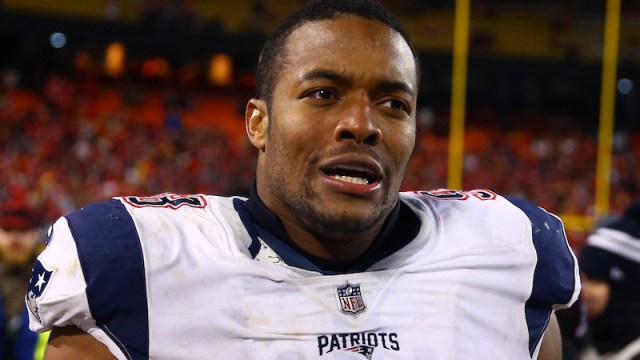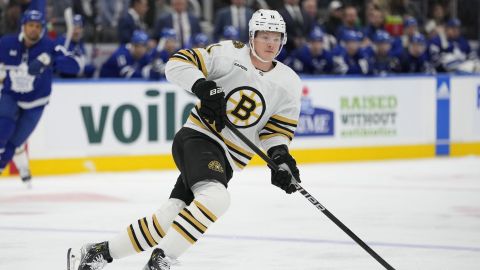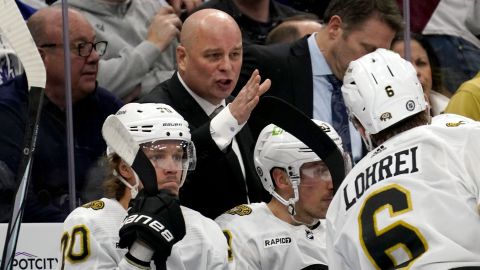One day, possibly, the Boston Bruins will have a fully healthy roster. When that might happen remains unclear, but in due course one has to think currently injured skaters soon will be mixed back into the fold.
So if/when that day comes, who should dress for a full-strength Bruins team?
That’s a question head coach Bruce Cassidy eventually will have to answer, and doing so won’t be easy
In Thursday’s loss to the Winnipeg Jets, the B’s were without David Pastrnak (thumb), Jake DeBrusk (lower body), Marcus Johansson (lung contusion), Torey Krug (upper body), Matt Grzelcyk (arm) and Kevan Miller (upper body).
While specific timetables for returns haven’t been given for each player, none of the above six skaters have been shut down for the season nor diagnosed with anything long-term.
With that in mind, when the puck drops in Game 1 of the all-but-guaranteed Bruins vs. Toronto Maple Leafs first round playoff matchup, which lines and pairings make the most sense?
Assuming everyone’s healthy, let’s start with the forwards.
Brad Marchand–Patrice Bergeron–Danton Heinen
Jake DeBrusk–David Krejci–David Pastrnak
Marcus Johansson–Charlie Coyle–David Backes
Joakim Nordstrom–Sean Kuraly–Chris Wagner
(Scratch: Noel Acciari)
The best version of Danton Heinen we’ve seen all season has been when he’s playing on the top line. He’s a more sound defensive player than Pastrnak, and he hasn’t shown he can be leaned upon to be a line’s primary scorer when playing in a bottom-six role. Keeping Heinen up with Bergeron and Marchand seems like a good way to maximize the value of a player that could be a postseason X-factor.
Placing Pastrnak on the second line wouldn’t exactly be a waste of his talent, as he and countryman David Krejci have tremendous chemistry. Krejci long has been at his best when he doesn’t have to be his line’s top shooter, and putting Pastrnak and DeBrusk with him is a good way to provide the center with far more help than he needs. And given the revolving door of linemates Krejci has had this season, he could use the stability of DeBrusk and Pastrnak.
The third line has been a maligned group this season, regardless of what combination it is. Coyle was acquired at the deadline to give the Bruins a reliable third-line center, and while he hasn’t stuffed the stat sheet, it hasn’t been for a lack of chances or quality play. Getting a healthy Johansson on Coyle’s left will provide the center with a winger that has top-six ability and isn’t afraid to shoot. And while David Backes hasn’t been pushing for the Art Ross this season, he’s often been playing with one or two other linemates who also contribute best offensively right in front of the net. Putting Backes with Coyle and Johansson will allow him to wreak havoc at the top of the crease, where he often does his best work.
Then there’s the fourth line. Some combination of Joakim Nordstrom, Sean Kuraly, Chris Wagner and Noel Acciari has been productive all season, and scratching one of the four wouldn’t be easy. But the Nordstrom-Kuraly-Wagner trio arguably was the best unit at any point, and one can’t help but wonder if they’d still be together now had Nordstrom not gotten hurt during the Winter Classic. Sure, Nordstrom’s scoring drought has drawn the ire of some, but he’s one of the Bruins’ best defensive forwards, penalty killers, forecheckers and backcheckers, and it doesn’t hurt that he also is one of their best skaters. In the postseason those things matter, and he deserves to play.
Now let’s address the defense, which is far less complicated.
Zdeno Chara–Charlie McAvoy
Torey Krug–Brandon Carlo
Matt Grzelcyk–John Moore
(Scratches: Kevan Miller, Steven Kampfer)
The top two pairings pretty much are no-brainers, as is half of the third pairing. So, the question then becomes, should Moore or Miller play?
At first blush, Miller, who has occupied the third pairing right side role much of his career, should just slide right into that spot. But injuries have marred the 31-year-old blueliner’s season, so that should lead to some healthy skepticism about his effectiveness when he returns.
Moore has had a solid year, and the only reason he has been healthy scratched for stretches is because Boston had more than six quality defensemen who deserved to play. The 27-year-old is by no means a bad penalty killer, and his skill with the puck gives him a bit more offensive upside than Miller.
Truthfully, what might dictate who plays, and when, are the matchups. Miller is a far heavier player, while Moore provides a bit better pace. Cassidy showed last postseason he’s not afraid to tinker with the lineup based on what style he thinks will give the Bruins the best chance to win, so if everyone’s healthy it wouldn’t be surprising to see him take guys in and out of the lineup.
Overall, a Bruins team with a clean bill of health would be the enviable position of healthy scratching players purely because of numbers, not performance.
And in that case, Cassidy really can’t go wrong.






